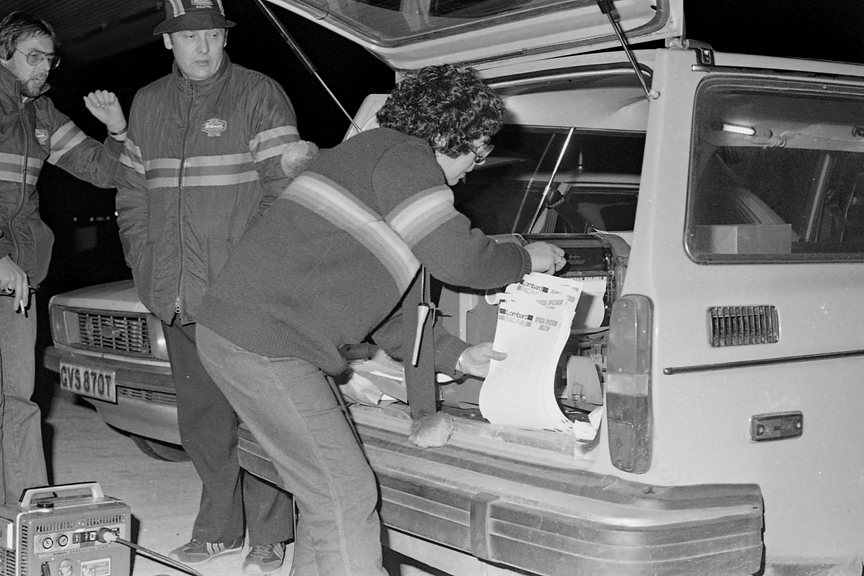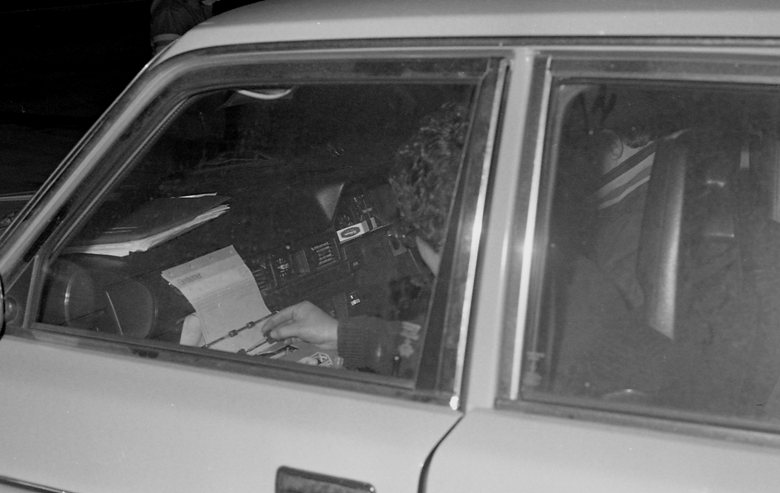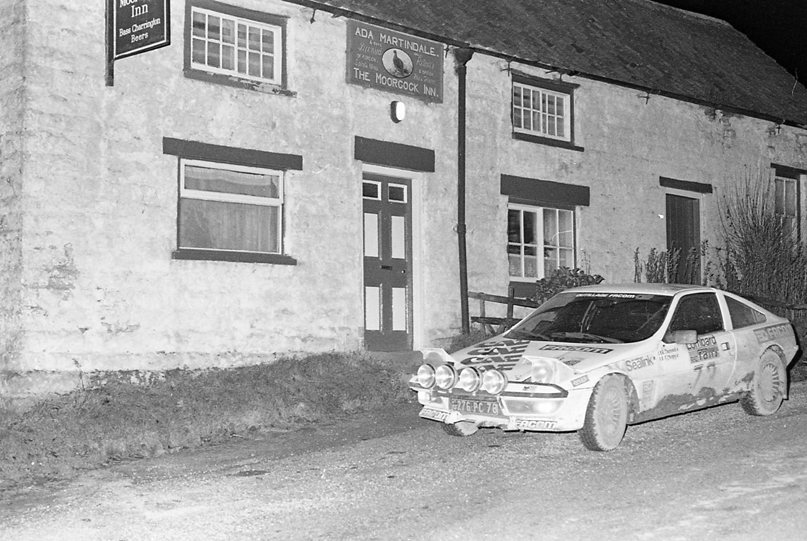Before the Internet
Although many younger rally competitors and fans enjoy looking back at films and photographs of rallies past, featuring such historic delights as Minis, Chevettes, Sunbeams, Corollas and Escorts, they don’t know much about the working background of the sport before mobile phones and laptop computers.
Indeed, 40 and more years back, most rally fans headed for home after an enjoyable day’s spectating not really knowing who actually won the rally they had been watching. That included many competitors on that self same event who also went home not knowing how well or how poorly they had done. They had to wait for the Final Results to pop through their letter box anything up to 7 days later – or they could listen into BBC Radio Scotland for the sports results programme at 6 o’clock (back when the BBC actually reported on rallying!) for the top ten and a 30 second roundup!
That was because the recently introduced very expensive computerised results services were really only used on International events like the Lombard RAC and RSAC Scottish, and even then, they were simply more complex calculating machines. In fact it wasn’t until Martin Liddle (Tynemouth Computer Services), known in some circles as ‘Sparky the Electronic Wizard’ came up with a self built computer encased in a plywood box in the early 1980s that the sport entered a ‘new’ age. This electronic contraption was transported to and from National and Clubman events right across the country and ultimately led to the fazing out of manual results on most events.
Think about it, before computers, a Results Team had to calculate the individual stage times for entries of 100 cars, or more, contesting anything up to 10 or maybe 12 stages. Not just that, but Arrival Times and Passage Control times had to be checked and any Road Penalties calculated. This was often a long and laborious process. A process which could be complicated and extended if any crew lodged a Query or Protest, which required more manual checking.
No wonder fans and competitors left before Final Results were announced. It could be some hours after the last car that they might be declared Final. Having said that, many results team excelled themselves in their turnaround times. Most had their own systems with the best declaring results provisional just minutes after the last car in some cases. Thinking back, what they achieved with pen and paper in a day’s sport was quite incredible.
By the same token, the issue of field results and competitor information during an event became an industrial art form in its own right. Rally HQ would call up manned telephone boxes and give the Marshals and Officials leaderboards and times ahead of the rally arriving at that point. The Marshals would note down the top ten or twenty times and chalk them up on blackboards for crews to note as they stopped to present their Time Cards.
In fact, Passage Controls had to be sited near these public phone boxes which were used in turn by Marshals, Officials, Results Team members and Information Crew volunteers who all had to share the facility!

Spectators in the know would often spot these Controls and stop for an update and then pass it on. But it took an enterprising couple from Northern Ireland to come up with the best invention since thermos flasks. Some major events were already offering a field results system whereby times were printed off at remote locations on route and handed out to competitors, but what Brian and Liz Patterson did was take that a stage further with their ‘RallyNews’ bulletins.
Not only did they issue Provisional leaderboards, but Brian would add snippets of interesting news and gossip regarding the competition’s progress. Taking that a stage further, they carried a small generator in the boot of their Volvo estate and a duplicator printer. This was a machine with an ink filled drum around which was wrapped a stencil. Using a manual ribbon-less typewriter balanced on her knees in the front seat of the car Liz ‘cut’ the stencils which were then taken to the duplicator in the boot, wrapped around the drum and hundreds of copies of their Results Bulletins were run-off within minutes.
These were then distributed to the Field Results Teams and delegated Information Officers, while supplies were given to volunteer Bulletin distribution crews whose job it was to distribute them free of charge to a wider audience. They were dished out in spectator and service areas, and given to Marshals to hand out as competitors and spectators passed by. It was quite a labour intensive operation but great fun for all those involved.
It was a tremendous service. What made it so special was that Brian was often ahead of the official results teams. As he interviewed drivers for nuggets of information he asked the co-drivers what their times were and was able to compile a very provisional, but unofficial, top six or ten so that the Bulletins could be run off and sent out ahead of the field. The ‘RallyNews’ service was soon in demand right across the British and Irish Isles. Their system was copied by quite a few others, but never bettered. Folk who thought they could do better quickly found out just how much planning and effort was required before the event and the sheer graft during it to make the system work.

The photos show the team at work on the 1981 Lombard RAC Rally with Liz typing up Brian’s dictation notes in the front seat before manning (womanning?) the duplicator printer. It’s perhaps also worthy of note that it was considered dangerous to approach Liz while she was typing, such were the tight deadlines to which the team were working. The unknowing would be quickly repelled by one of Liz’s favourite sayings: “Dae ye waant a moothfae o’ dandruff?” which was uttered in a bold but confident attempt at a Scottish accent!

This temporary base of operations (in the photographs) was just outside the rather quaint Moorcock Inn at Langdale End in the huge Dalby Forest complex. This location was chosen simply because it had a red telephone box near the stage exit and close to the pub.
It was indeed a very busy phone box that night being used in rotation by Results crews in constant communication with Rally HQ and with Information crews feeding the Press Office with the results of their own news gathering exploits. These hand-picked volunteer Information Crews were ’employed’ by the Rally HQ Press Office and leapfrogged each other to get to stage finishes, snatch a word with the drivers, and then report back via a phone line to Rally HQ. This information was used by the Press team back at base issuing Reports and Releases on the rally progress to national and local newspapers throughout the British Isles.
Regarding the Moorcock, I say ‘quaint’ but that’s a polite term. Served up by the elderly proprietrix, Ada Martindale, there was more raw penicillin in the cheese sandwiches than the medicinal stock room at Boots, either that or the ‘furry blue’ speckled bread had come out in sympathy with the blue cheese! The trouble was, one Information crew was so hungry that after a quick scrape of the stale bread with a blunt knife, the sandwiches were eaten.

Looking back it’s remarkable just how much was achieved given the basic mechanical technology and limited resources at the time. Those who are used to instant communication via the mobile phone or Internet these days will find it difficult to comprehend the logistical hurdles, planning the use of the public phone service box network and the huge numbers of volunteers which were required to make this work. For instance, although the Ordnance Survey maps highlighted the location of these telephone boxes, they had to be checked out before a rally to ensure they were in fact operational!
Mind you it wasn’t just public phone boxes that were used, private phones in houses and service stations, public halls and business offices along the route were often pressed into service with the willing support of enthusiasts and non-enthusiasts. Many’s the time we saw a Marshal standing outside a private house with the phone line snaking across the garden and through a window to be connected with Rally HQ. And all this had to be planned, recce’d and agreed before a wheel had turned in anger.
This was indeed a much valued service back in the day, and one that was copied by a certain notorious character on the similar, but smaller scale, ‘MullMurmurs’ Bulletin service on the Isle of Mull for many years.
Aye, them were’t days.